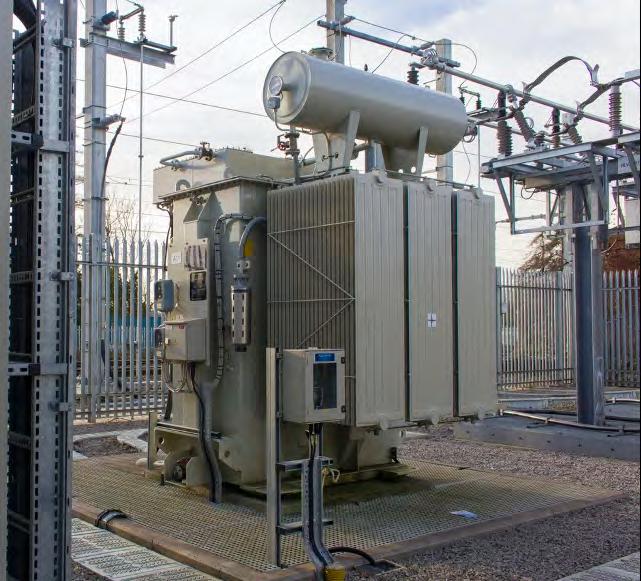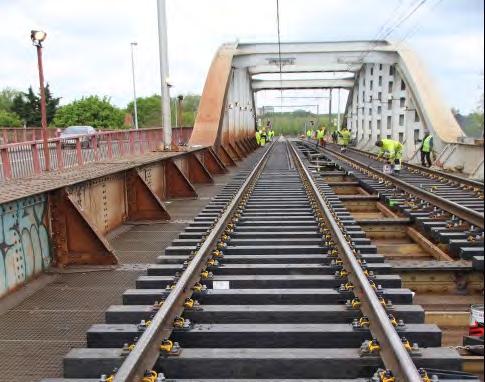
18 minute read
Understanding polymer railway sleepers
by The PWI
AUTHOR: Aran van Belkom
Aran van Belkom is Technical Director of Lankhorst Engineered Products in the Netherlands, Europe’s leading manufacturer of recycled polymer products. Amongst other products, Lankhorst has produced polymer railway sleepers since 2005. Aran is a Member of the European and ISO standardisation committee for polymer sleepers and is currently performing a PhD research at the University of Southampton on the topic of polymer railway sleepers.
Advertisement
AUTHOR: Louis Le Pen
Dr Louis Le Pen is a Senior Research Fellow at the University of Southampton and specialises in laboratory testing and field research into the performance of railway track systems. Over the past 15 years he has worked on research projects funded mainly by the UK’s EPSRC, Network Rail and the European Union. He has authored over 40 publications and his work has been recognised most notably by an honourable mention for the Quigley Award (Canadian Geotechnical Journal) and the BGA medal (Geotechnique). He is also co-editor of the Cross-Industry Track Stiffness Working Group’s “A Guide to Track Stiffness”.
ABSTRACT
Railway sleepers are principally timber or concrete. However, timber sleepers have a relatively short life expectancy (unless they are preserved with creosote which is bad for the environment and often banned) and concrete sleepers are hard on the trackbed because of their bending and compressive rigidity and because of their surface hardness. Polymer sleepers have the potential to combine the best characteristics of both principal sleeper materials – the lower bending and compressive rigidity of timber and its more compliant surface hardness along with the consistency and lifespan of concrete. However, the viscoelastic behaviour of polymer materials makes assessing their suitability as sleepers difficult owing to time and temperature dependent material behaviour such as creep, strain rate dependency and viscous damping. A complicating factor is the lack of functional performance requirements in current sleeper standards. It is suggested that track loading calculations should form the basis for determining suitable sleeper bending stiffness and strength properties, starting from the desired track support stiffness. This approach requires testing methods for polymer sleepers to incorporate load durations and strain rates that are comparable with actual track loading. Only then will testing provide reliable indicators of actual polymer sleeper performance.
INTRODUCTION
Today, the world’s railway networks have around three billion sleepers in use, most of them timber or concrete, with an annual demand for 60-150 million new sleepers1 . However, the creosote that is used for the conservation of timber sleepers is environmentally damaging. Without creosote, the lifespan of a timber sleeper is limited and use of scarce hardwood can promote deforestation. For completely new track, concrete is often favoured, but concrete is rigid (too rigid for some applications, eg Figure 1) and has a greater tendency to promote locally high impact loads2 .
Ideally a sleeper would combine the lifespan and consistency of a concrete sleeper with the mechanical properties of a timber sleeper. Polymer sleepers could provide such characteristics. However, the widespread introduction of a new sleeper material is challenging. Existing sleeper standards for acceptance testing have been prepared for existing materials and in any case lack functional requirements that could be transferrable to other materials. Potential suppliers and users of polymer sleepers must therefore determine new methods of assessment to determine whether polymer sleepers have suitable mechanical properties. Accomplishing this requires a combined understanding of railway track and polymer behaviour. Several reviews have been published on polymer sleepers3,4,5 . These reviews all identify the lack of suitable rail industry standards and the relatively brief field experience with polymer sleepers. However, outside of the rail industry there already exists an established understanding of polymer material behaviour with the potential to be applied for the development of polymer sleepers considering their viscoelastic material behaviour.
This article focusses on how viscoelastic behaviour effects polymer sleeper performance and discusses how to specify testing to predict polymer sleeper behaviour in track. The differences between polymer, concrete and timber sleepers are discussed. Currently available sleeper acceptance standards are reviewed and a background on the mechanical behaviour of polymers is given. This article will aid practitioners to better understand the potential effects of polymer sleeper viscoelasticity on track behaviour, and more specifically, the differences that can be expected between behaviour in tests and behaviour on track. Recommendations are made for testing and assessing polymer sleepers.
CURRENT SLEEPERS IN TRACK
TIMBER SLEEPERS - Timber possesses desirable mechanical properties for a sleeper; it combines a relatively high bending stiffness with a low compression stiffness and a soft sleeper-ballast interface. The bending stiffness is important for the even distribution of forces between the sleeper and ballast over its length. The low compression stiffness and soft interface reduce sleeper loads and impact forces.
Although timber can have desirable mechanical properties, in practice those properties can vary significantly6 . Consequently, the load transfer characteristics can vary, creating differences in sleeper loads and in settlements along the track length.
Timber comes in two primary types, softwood and hardwood, with the former mostly having lower bending stiffness and shorter lifespan. Softwood sleepers can be impregnated with creosote to increase lifespan4 . However, owing to health concerns7 the European Union has forbidden the use of creosotes8 . The lifespan of an uncreosoted softwood timber sleepers is limited to normally 8-12 years, depending on wood species and climatic conditions9 . Hardwood has a longer lifetime expectancy, but hardwood is becoming less available and of decreasing quality4 . A major environmental issue using hardwood is deforestation7 .
CONCRETE SLEEPERS - Concrete sleepers offer a high strength and a lifespan of normally 40-50 years. Concrete sleepers have significantly greater bending stiffness and surface hardness compared with timber or polymer sleepers. These characteristics result in relatively high bending moments, rail seat loads and locally high ballast contact stresses10 . Concrete sleepers are also susceptible to fracture from impact and offer little damping of vibrations. Damping must instead be provided by the ballast bed and rail pad3 . Anything that reduces the ability of ballast to provide damping, for example fouling from coal dust or sand, can promote higher impact loads and premature failure of concrete sleepers2 (Figure 2). The high weight of concrete sleepers aids the lateral stability of track, but increases transportation and installation costs3,4 .
POLYMER SLEEPERS
In recent years sleepers from polymer materials have been introduced. The choice of which polymer to use for a sleeper is governed mainly by mechanical properties and price. This means that commodity (or bulk) polymers are often selected (Figure 3).
About 50% of the volume of all polymers produced falls in the category of the polyolefins, consisting mainly of: High Density Polyethylene (HDPE), (Linear) Low Density Polyethylene ((L)LDPE) and Polypropylene (PP)11 . Polyolefins have mechanical properties that are time and temperature dependent. For voluminous products like sleepers the use of recycled material is preferred.
Polymers are sometimes combined with other materials and can be subclassified depending on the combination of materials present:
• Fibre reinforced polymers are those where glass fibres are mixed into the polymer melt. • Hybrid sleepers have a polymer matrix and contain discrete reinforcements which are continuous over the length of the sleeper eg glass fibre or steel bars (Figure 4). This type of reinforcement gives greater strength and bending stiffness. The term composite - a material that is made from several different substances - is used for polymer sleepers, but sometimes has a narrower meaning ie fibre reinforced polymers. To be clear about including both types of sleepers, the term polymer sleepers is used throughout this article.
Polymer sleepers are increasingly being used to replace timber sleepers as creosotes are phased out and uncreosoted softwood sleepers have a limited lifespan (Table 1).
Polymer sleepers may also be used in places where concrete is too rigid (eg on steel girder bridges) or where trackbed support stiffness changes abruptly and concrete sleepers are overly damaging to the trackbed. For example, onto/off of bridges or other engineering structures and over complex track arrangements such as switches and crossings (S&C). At such locations maintenance needs and associated costs are disproportionate compared with plain line. In common with timber, polymer sleepers/bearers can be drilled for varied baseplate positions along S&C. For a concrete sleeper, the fixing positions must be precast at the factory adding cost and planning needs. Timber in larger dimensions (as needed for S&C) has availability issues. Other potential benefits for polymer sleepers include their use in:
• Situations where weight is critical (Figure 5). • Situations with poor drainage, such as track embedded in roadway pavement, due to its resistance against water and moisture. • Areas with limited accessibility for maintenance, such as tunnels and bridges. • Areas which suffer from ballast fouling. • Areas with noise or ground vibration issues. • Areas where spot replacement of timber sleepers is required.
MECHANICAL BEHAVIOUR OF POLYMERS
The mechanical behaviour of polymers depends on the duration of loading (and on temperature). This dependence must be taken into account when designing tests for polymer sleepers.
Steel, wood and concrete can be considered as elastic materials (for small strains). Elastic materials strain when loaded and quickly return to their original state once the stress is removed. The material behaviour can be modelled as a spring. For viscous liquids, the stress is proportional to the strain rate and independent of the strain itself. These materials can be modelled as a dashpot (damper). Polymers are viscoelastic materials having elements of both of these properties and can be modelled with combinations of springs and dashpots. This implies that the mechanical properties of polymers are a function of time. When a polymer is loaded with a constant load, the strain will increase over time, at a declining rate (creep). When the stress is taken away, the viscous part will initially remain, fading away over time (Figure 6)13 .
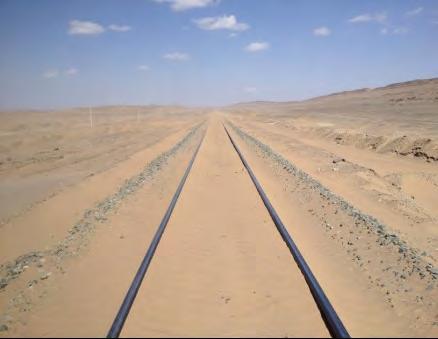
Viscoelasticity also creates strain rate dependent behaviour. The material will exhibit a higher Young’s modulus and peak strength when loaded at a higher speed. Properties of polymers therefore have to be determined at loading rates comparable to the actual load case (Figure 7). When loading a polymer, the stress-strain graph will follow the top line of Figure 8: the stress-strain relationship is non-linear. Unloading follows the bottom line and heat is dissipated due to hysteresis. The grey area in Figure 8 indicates the energy lost (work done) through the viscous damping of the material. This energy is dissipated by the material. In a repeated loading test this can lead to heating up of the material. Because material properties change at elevated temperatures, this testing effect should be avoided. The material damping and a low compression stiffness of the polymer helps by reducing impact loads15 . Comparative impact testing shows a 25% reduction of impact loads on a polymer sleeper compared to concrete (Figure 9).
CURRENT SLEEPER TESTING STANDARDS
Sleepers must pass certain tests before they can be accepted for widespread use. However, most test methods in current standards are not suitable for the assessment of polymer sleepers because they have been developed for timber or concrete.
NON-POLYMER SLEEPER STANDARDS - EN13145, the standard for timber sleepers and bearers, specifies dimensional tolerances, allowable defects, durability/preservation guidelines and wood species. These specifications are based on the 200 years of experience showing that a timber sleeper of certain dimensions functions acceptably, but there is no explicit explanation of functionally quantified mechanical characteristics. This lack makes it difficult to introduce new sleeper material types.
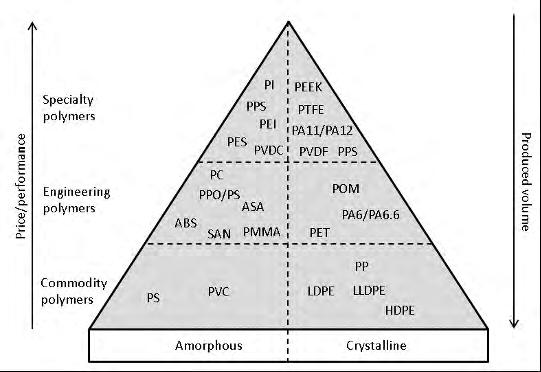
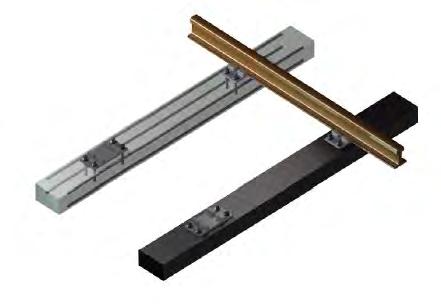
For concrete sleepers, product requirements and test methods are described in EN 13230 and ISO 22480 (draft). The sleeper bending moment calculation methodology shown in EN 13230-6 annex A comes closest to providing functional requirements. However, this calculation assumes that a sleeper is undeformable, which is perhaps defendable for concrete, but not for polymers or timber16 .
STANDARDS/GUIDANCE FOR THE USE OF POLYMER SLEEPERS - The Japanese standard JIS E1203 describes performance requirements for glass roving (yarn spun from glass filaments each with a diameter of a few µm) reinforced polyurethane sleepers. The basis is to mimic the properties of timber, reasoning that if the material properties are similar, the sleeper will perform similarly. However, it is impossible to exactly mimic every timber value, and this standard would seem to preclude the potential for improvement in performance that could be achieved from use of alternate sleeper materials.
The American Railway Engineering and Maintenance-of-way Association (Arema) published a standard in 2009 for Engineered Composite Ties17 . That Arema standard has been used in some countries as a low-end requirement. The standard was based on experience gained from track tests, but did not relate track circumstances to requirements. This made it difficult to judge whether the performance in one track location can predict the performance in another location. Based on continuing site observations and research, Arema updated its standard and guidance in 2018.
The draft standard ISO 12856 on polymeric composite sleepers, published in 2020, provides the most appropriate testing methods by taking into account the viscoelastic behaviour of polymers. It also includes a bending moment calculation methodology, comparable to EN 13230-6, considering the sleeper as a deformable body. However, this standard does not define functional requirements.

Table 1: Expected lifespan of different sleeper types5,9,12 .
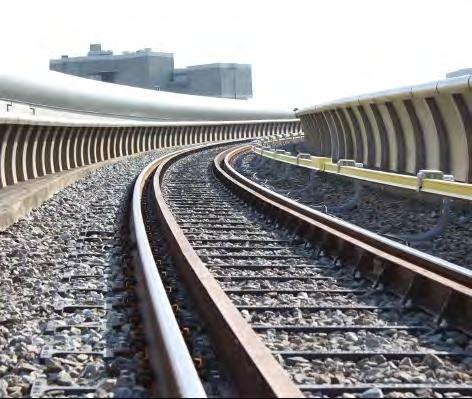
The lack of polymer specific testing based on functional requirements has led railway companies to test polymer sleepers using methods for timber or concrete sleepers, which both have downsides:
FURTHER FUNCTIONAL DIFFERENCES FOR IN TRACK PERFORMANCE
Both timber and concrete sleeper testing requirements have inconsistencies compared with polymer sleepers when considering real functional behaviour.
COMPARING POLYMER PROPERTIES WITH GENERAL TIMBER PROPERTIES - General timber properties are normally determined with a moisture content of 6%. In an outdoor application, such as for a sleeper, a moisture content of 20-25% is expected, giving a 20% reduction in Young’s modulus and a 40% reduction in bending strength18 . Additionally, timber bending standards like ISO13910 determine Young’s moduli from large span bending tests, in which shear deformation is neglectable. For a short beam such as a sleeper, shear creates additional deflections of around 15%. Verification testing performed on oak sleepers gave a Young’s modulus of 5.5 GPa (Figure 10), confirming that the measured bending stiffness of timber sleepers tends to lie around 30% below generic values, which are determined in optimal conditions19 . Comparing polymer with timber sleepers therefore would require actual testing of timber sleepers in the same test setup, taking a large enough sample size into account due to the variability of timber properties and considering the effect of moisture. USING CONCRETE SLEEPER REQUIREMENTS - Concrete sleepers deform less, and consequently concrete sleeper supported track deflects less over a shorter deflection curve along the track length. This both leads to higher bending moments in the sleeper and locally higher peak vertical stresses on the trackbed for the same wheel load and trackbed support stiffness. Typical load transfer proportions are shown in Figure 11 for a wheel load directly above a sleeper15 .
Figure 12 shows the track deflection with a typical concrete, polymer and timber sleeper15 . For a concrete sleeper the compression of the railpad and the trackbed creates 95-98 % of the total track deflection. For a polymer or a timber sleeper there is an additional deflection at the rail seat location due to the bending of the sleeper, and also the sleeper compression creates an additional deflection, in combination accounting for 30% of the track deflection. This means that a timber/polymer sleeper has more load distribution over the sleepers in track and consequently maximum sleeper forces are lower. The sleeper should therefore be considered as a deformable body when translating track loads into sleeper loads.
RECOMMENDATIONS
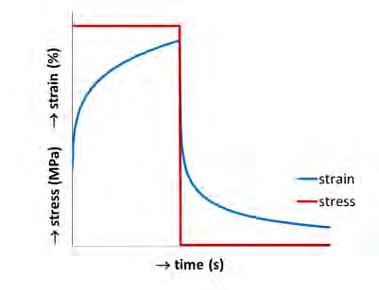
Figure 6: Stress-strain relation in polymers.
Figure 7: Strain rate dependency of High Density Polyethylene, tested on ISO tensile bars.
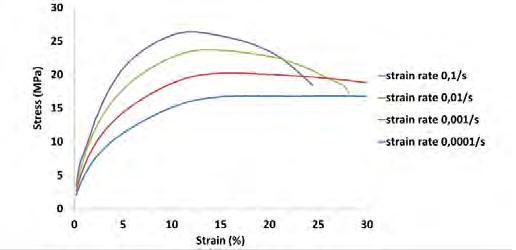
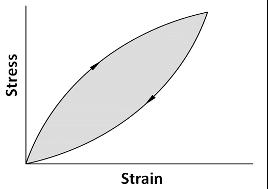
When introducing polymers sleepers in track, it would be recommended to:
• CONSIDER THE SLEEPER AS A DEFORMABLE BODY The deformation of a sleeper reduces the bending moment and peak trackbed stresses. For the calculation of the sleeper strength requirements the influence of the sleeper bending stiffness needs to be considered.
• DEFINE SLEEPER STRENGTH AND STIFFNESS REQUIREMENTS BY CALCULATION Instead of taking timber or concrete sleeper requirements, a calculation based on track support, the rail bending stiffness and railpad properties should be carried out to determine the appropriate sleeper strength and bending stiffness. In most situations the desired track support stiffness will be the best starting point.
• PERFORM SLEEPER ACCEPTANCE TESTS DYNAMICALLY CONSIDERING THE INTERVALS BETWEEN LOADING EVENTS Testing should be performed dynamically, at loading speeds that can be expected on in-service track. Only under these circumstances is it possible to properly assess the performance of polymer sleepers. In the case of repetitive loads, the sleeper temperature should be monitored and if needed, paused to prevent an unrealistic material hysteresis heat build-up.
These recommendations are for the larger part incorporated in the new ISO 12856 standard. Sleeper testing is performed dynamically and the bending moment calculation methodology, as described in the standard, incorporates sleeper deformability. This calculation methodology also aids in understanding the relation between track performance and sleeper characteristics, but the standard does not translate this into sleeper requirements. This step would have to be taken by the track owners.
The UIC (Union Internationale des Chemins de ferre) aims to provide a recommendation sheet for polymer sleeper requirements based on the properties of timber sleepers. The downside of this approach is that it disregards the second recommendation (to define sleeper strength and stiffness requirements by calculation). If that recommendation was adopted, it would open up the possibility for polymer sleepers to be further optimised. For example, by tuning the volumetric material distribution or the sleeper to ballast contact area distribution would modify the bending stiffness and contact stresses present to potentially further improve track performance in ways not currently possible with concrete or timber sleepers.
ACKNOWLEDGEMENTS The author would like to thank the co-members of the ISO committee on polymeric composite sleepers and Professor William Powrie at the University of Southampton for the elaborate discussions on sleepers, polymers and track performance.
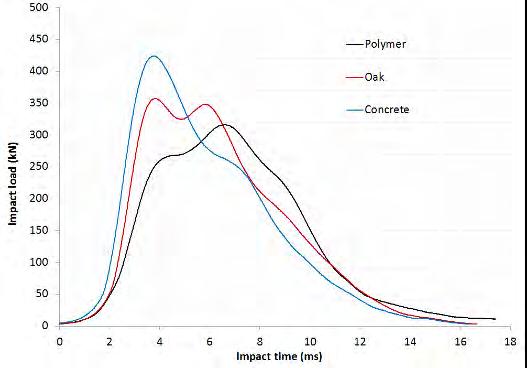
Figure 9: Impact testing by a vertical 2kJ impact load according to EN13146-3 performed on polymer, concrete and timber sleepers. Figure 10: Three-point bending testing of 150(h) x 250(w) mm oak sleeper (span 1435 mm, loading speed 76 mm/min).
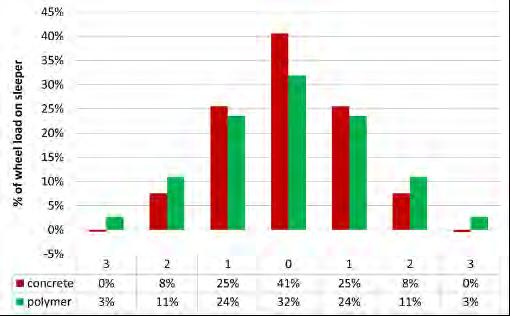
Figure 11: Calculation of typical distribution of a wheel load over the sleepers for a polymer sleeper with bending stiffness 150 kNm2 and for a concrete sleeper with bending stiffness 6 MNm2 on ballast with a 0.1 N/mm3 bedding modulus. The wheel load is exerted directly above sleeper number 0, sleepers number 1, 2 etc. are 600 mm c.t.c. apart15 .
LITERATURE
1. “International Federation for Structural Concrete, Precast concrete railway track systems, state-of-art report,” 2006, bulletin 37. 2. J. A. Zakeri and R. Abassi, “Field investigation of variation of loading pattern of concrete sleeper due to ballast sandy contamination in sandy desert areas,” Journal of mechanical science and technology, vol. 26, no. 12, pp. 3885-3892, 2012. 3. W. Ferdous, A. Manalo, G. v. Erp, T. Aravinthan and S. Kaewunruen, “Composite railway sleepers - recent developments, challenges and prospects,” Composite structures, vol. 134, pp. 158168, 2015. 4. A. Manalo, T. Aravinthan, W. Karunasena and A. Ticoalu, “A review of alternative materials for replacing existing timber sleepers,” Composite structures, vol. 92, pp. 603-611, 2010. 5. S. Kaewunruen, R. You and M. Ishida, “Composites for TimberReplacement Bearers in Railway Switches and Crossings,” Infrastructures, Vols. 2,13, 9 october 2017. 6. T. Ticualu, T. Aravinthan and W. Karunasena, “An investigation on the stiffness of timber sleepers for the design of composite sleepers,” Centre of Excellence in Engineering Fibre Composites, Faculty of Engineering and Surveying, University of Southern Queensland, Toowoomba, Queensland, Australia. 7. A. C. Nioac de Salles, L. Z. Loureiro Legey, L. Pinguelli Rosa, E. B. Acordi Vasques Pacheco and J. Woidasky, “Comparative Analysis of the Carbon Footprint of Wood and Plastic Lumber Railway Sleepers in Brazil and Germany,” in Plastics and the Environment, Chapter 5, pp. 59-79. 8. Directives, “Commission directive 2011/71/EU of 26 July 2011,” Official Journal of the European Union, p. L195/46, 27-7-2011. 9. W. W. Hay, Railroad engineering, New York, Chichester, Brisbane, Toronto, Singapore: John Wiley & Sons, 1982. 10. T. Abadi, L. le Pen, A. Zervos and W. Powrie, “Measuring the area and number of ballast particle contacts at sleeper/ballast and ballast/subgrade interfaces,” The international journal of railway technology, vol. 4, no. 2, pp. 45-72, 2015. 11. Plastics Europe, Plastics - the facts 2017, Association of Plastics Manufacturers, 2018. 12. Prorail, “Levensduurverwachting spoor en wissels ten behoeve van vervangingsplannen BID00020-V001,” 2014. 13. J. D. Ferry, Viscoelastic properties of polymers, New York, London, Sydney, Toronto: John Wiley & sons, Inc., 1970. 14. A. v. d. Vegt, From polymers to plastics, Delft: Delft University Press, 2002. 15. A. v. Belkom, “Recycled plastic railway sleepers, analysis and comparison of sleeper parameters and the influence on track stiffness and performance,” Edinburgh, 2015. 16. A. v. Belkom, “A simplified method for calculating load distruibution and rail deflections in track, incorporating the influence of sleeper stiffness,” Advances in structural engineering, vol. 23, no. 11, pp. 2358-2372, 2020. 17. Arema, Manual for Railway Engineering, Chapter 30, Part 5, 2009. 18. C. Gerhards, “Effect of moisture content and temperature on the mechanical properties of wood: an analysis of immediate effects,” Wood and fiber, vol. 14, no. 1, pp. 4-36, 1982. 19. A. Manalo, T. Aravinthan, W. Karunasena and S. Douglas, “Fibre composite sandwich beam, an alternative to railway turnout sleeper?,” in Southern Region Engineering Conference, 11-12 November 2010, Toowoomba, Australia, 2010.
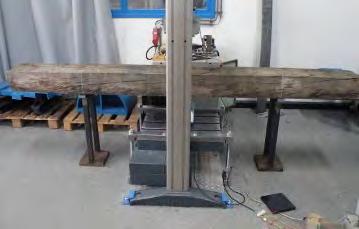
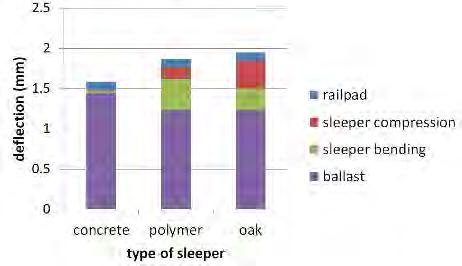
Figure 12: Break-down of track deflections for different sleeper types (as defined in Figure 11)15. (“ballast” considers the mean ballast compression under the sleeper. “Sleeper bending” gives the additional ballast compression at the rail seat due to the bending of the sleeper).

